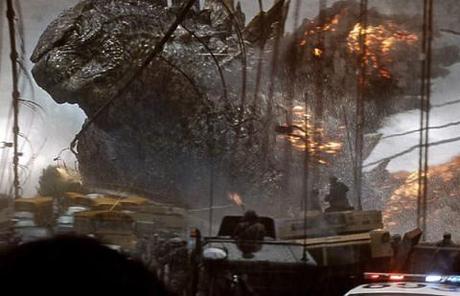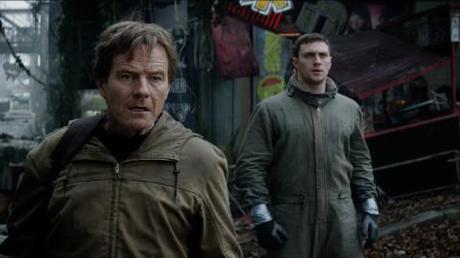
by Steve Habrat
In 1954, Japanese production company Toho Co. released director Ishiro Honda’s Godzilla, an apocalyptic reflection about the dawning of the Atomic Age and the horrors of the bombs dropped on Hiroshima and Nagasaki. Godzilla certainly didn’t shy away from delivering extended sequences of earth-shaking destruction, but the devastation was measured against absorbing human drama that made the film all the more eternal. In the wake of its release, Godzilla sparked “Kaiju” (Japanese for “giant monster”) fever around the world, leaving audiences with a hankering for more monster mayhem. In 1998, after multiple sequels that grew increasingly campy in quality, director Roland Emmerich decided to revive the king of monsters for American audiences, but the results proved disastrous and sent Godzilla sulking into the deepest depths of the Pacific for sixteen long years. After years of rumors and speculation about a new Godzilla movie in the works, we finally have director Gareth Edwards’ Godzilla, an old-fashioned blockbuster in the vein of early science-fiction creature features. Taking its sweet time to work up to the monster smashing and bashing, Godzilla 2014 goes the route of Honda’s ’54 original and injects both emotional weight and jittery nuclear paranoia right into the film’s heart. It’s an admiral attempt from a director whose only other directing credit is a low-budget indie movie from 2010 called Monsters. Despite some flailing human drama and more than a few avoidable clichés, Godzilla 2014 is an exhilarating rush that brings the legendary beast back to the silver screen with must-see style.
Godzilla 2014 begins in 1999 in Janjira, Japan, with nuclear physicist Joe Brody (played by Bryan Cranston) discovering strange seismic readings surrounding the nuclear power plant he works for. Despite Joe’s warnings to his superiors, work continues as usual at the plant, but when a tremor causes an explosion, the plant crumbles into ruin and sparks a mass exodus from the area. In all the chaos, Joe’s wife, Sandra (played by Juliette Binoche), is exposed to a deadly dose of radiation and is killed. In present day, Joe remains in Japan, convinced that the government is hiding something about that terrible day. Meanwhile, Joe’s estranged son, Ford (played by Aaron Taylor-Johnson), diffuses bombs for the US Navy and lives in San Francisco with his wife, Elle (played by Elizabeth Olsen), and their young son. Upon returning home from a tour of duty, Ford is called to Japan to bail Joe out of jail for trespassing in the quarantine zone. Joe presents Ford with startling new information that suggests that the government has indeed been covering something up. The two travel back to Janjira to do a bit more snooping and collect some of Joe’s old data, but local authorities discover them and take them into custody. Joe and Ford are brought to the ruined nuclear plant, which is housing an egg-like sack that is emitting the same seismic readings Joe picked up on in 1999. After the egg hatches and produces a giant winged creature, the Brody’s team up with two scientists, Dr. Serizawa (played by Ken Wantanabe) and Dr. Graham (played by Sally Hawkins), and the military to track the monster down and kill it. As the military rushes to stop the creature before it can claim more lives, another similar beast is discovered in the Nevada desert. With military strikes proving useless against the creatures, only one hope remains to restore order—Godzilla.
For fans of old-fashion summer blockbusters and classic drive-in monster movies, Edwards’ Godzilla is a gift from the cinematic gods. The opening hour puts most of its emphasis on character development and exposition, teasing us from the opening credits with tiny little glimpses of the title beast. Of course, that isn’t to say that the opening hour of Godzilla is completely monster free. As the film’s promotional campaign has stomped on, it’s become increasingly clear that Godzilla isn’t the only beast turning cities to pebbles. Edwards and screenwriter Max Borenstein pit Godzilla against not one, but two eight-legged terrors nicknamed MUTOs, which stands for Massive Unidentified Terrestrial Organism. The MUTOs are truly something to behold, and it is best not to reveal all of their secrets here, but just know that these critters are capable of some major carnage. To up the horror level, Edwards cleverly masks the MUTOs before really allowing us a good glimpse of them in broad daylight. The first time we see a MUTO, its concealed in flashing emergency lights as it fights its way out of a containment cage. From there, they are largely left in the dark, with helicopter spotlights and fiery wreckage illuminating their intimidating frame. It’s extreme effective and it keeps us strung along, always wanting just a little bit more of them. Keeping his monsters concealed also allows Edwards room to really deliver a grand finale that is the very definition of incredible.

While the first hour of Godzilla is a bit slower than most mainstream audience members may be used to, Edwards understands why we plunked down our hard earned money for a seat in the theater. The film’s special effects are worth the price of admission alone, as there are some truly epic set pieces that will blow you into the lobby of the theater. The first encounter between one of the MUTOs and Godzilla is something that will give you a sharp chill of excitement, especially as Godzilla belts out a might roar that shakes your every organ. The rest of the encounter plays out mostly on television screens, but it still looks might impressive even at a distance. Some of the other awe-inducing set pieces include Godzilla’s watery arrival that leaves the streets of Honolulu flooded, a devastated Las Vegas that was briefly glimpsed in the trailer, a fiery train track encounter between a group of soldiers and one hungry MUTO, and a terrifying showdown on the Golden Gate Bridge that leaves soldiers gaping in horror at jets tumbling out of the overcast skies. Considering that this is Edwards’ first foray into multi-million dollar blockbuster territory, he handles it like a professional and he uses the moments as wicked teases for a final act that stomps the puny human dramatics. I won’t reveal much about the final royal rumble, but know that it is everything a monster movie aficionado could possibly hope for. It’s a cinematic achievement that truly makes you feel like you’re in the action, darting between the feet of warring gods who are determined to rip each other to ribbons.
As early reviews of Godzilla have poured in, much has been made about the scripts one-dimensional characters and the phoned-in performances from some respectable names. Leading the pack is Bryan Cranston’s Joe Brody, who really isn’t given much screen time. He gets a small window to show off that explosive temper his fans have come to know and love, but he also gives Godzilla some misty-eyed heartbreak that leaves you wishing there was more of him. Taylor-Johnson is second in command as Ford, a formulaic action hero who manages to make it out of every single life-threatening moment with a bit of mud on his face, a slight limp, and a bloody nick on his forehead. Together, Cranston and Taylor-Johnson make an appealing on-screen duo, but their partnership is short lived. Olsen is passable as Elle, Ford’s pretty wife who is simply asked to hug her son close, worry about Ford, push a hospital stretcher around, and run in fright from an advancing Godzilla. Wantanabe’s Dr. Serizawa mostly stands around in amazement of the death and destruction around him, but he is entertaining as he ominously explains Godzilla’s backstory and suggests that the monsters should duke it out. Sally Hawkins is wasted in the background role of Dr. Graham, a character who mostly dashes around after Wantanabe’s Dr. Serizawa. Rounding out the main cast is David Strathairn as Admiral William Stenz, the cookie-cutter military man in charge of nuking the rampaging abominations into ash.
The biggest question surrounding Edwards’ Godzilla is whether or not American audiences are ready to embrace these towering monsters again. Last year’s Pacific Rim—which was director Guillermo del Toro’s giddy comic book tribute to Toho’s line of legendary kaiju—suggested that they might not be, as it opened to low numbers despite critical acclaim. While Godzilla’s marketing campaign has sparked mysterious intrigue, it stands as a reinvention that remains fiercely loyal to the shadowy agony and radioactive paranoia of the original. Does this Godzilla come with the same complexity and depth as Honda’s original? Well, it re-establishes the big guy’s atomic roots, and it dares to echo recent tragedies such as nuclear meltdowns, earthquakes, and tsunamis. There’s no doubt that this Godzilla is thought provoking, even when it transitions into drive-in mayhem in the second act. As far as Toho’s most loyal fans go, some may be disappointed by the lack of screen time Godzilla receives, but I truly think it works, especially when we look back at Atomic Age classics that concealed their monsters until it was absolutely necessary to show them off. In addition, monster fans will also get a big kick out of the subtle tributes to other Toho Kaiju. (Check out the name of Wantanabe’s character!) Overall, while the character drama may not especially noteworthy, Godzilla 2014 stands as an extraordinarily grand piece of monster movie making that is guaranteed to wow audiences, and sends off those with a soft spot for classic monster movies with a nostalgic adrenaline rush.
Grade: B+
